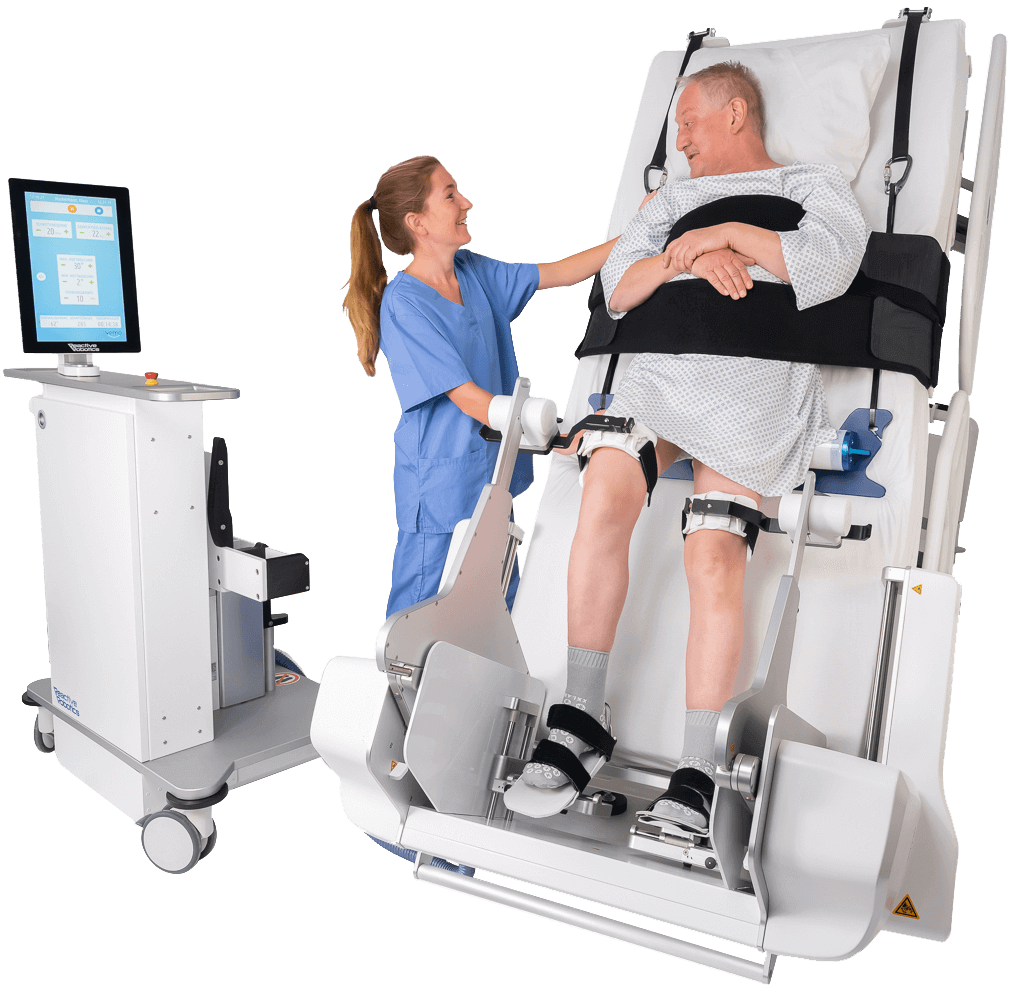Assistive robotics for early mobilization of bedridden critically ill and intensive care patients.

Everything you need to know about the features and benefits of the Vemo System: Early mobilization of bedridden intensive care patients by Reactive Robotics. need to know.
The VEMO SYSTEM combines continuously adjustable verticalization with robotic leg movement therapy Uniquely, patients can remain in their own bed and do not need to be transferred to separate equipment Safe and efficient early patient mobilization Early mobilization is part of the ABCDEF bundle and is seen as one of the most important therapies for preventing the negative effects of immobility The system complements manual therapy with an adaptive robotic assistance system and supports caregivers and therapists in mobilizing their patients. Customers are hospitals that want to provide the best possible care for their patients on their road to recovery and support their clinical staff with the best available technology.
Advantages for the healthcare system
Advantages for hospitals
Advantages for therapists
Advantages of the patients
Advantages of early mobilization
VEMO SYSTEM or VEM = Very Early Mobilization. It stands for a robotic assistance system for the mobilization of severely affected patients, especially intensive care patients.
The VEMO SYSTEM is the ultimate solution for patients with physical limitations. It consists of the robot with trolley, the verticalizable intensive care bed with mattress and the patient adapters for securing the patient during verticalization and mobilization. Thanks to this system, patients can finally mobilize and verticalize completely - without any outside help!
Studies show that targeted early mobilization significantly helps ventilated patients in particular to recover faster and can reduce ICU length of stay by about 23%.
If there are severely affected patients with a long expected lying time, mobilization by means of the VEMO SYSTEM is recommended, since transfer from the bed represents a great risk for both the patient and the user.
Therapy is performed directly in the intensive care unit, in the patient's bed. Dangerous transfers of patients to separate therapy equipment are avoided.
The risk of injury to nurses and therapists is reduced by supporting physically demanding work.
Either manually or autoadaptively through the patented Assist-As-Needed - AAN - technology. The specially developed patient adapters allow the VEMO SYSZEM to be adapted to patients of different statures.
VEMO SYSTEM provides a detailed record of the patient's therapy progress and activity. DSGVO-compliant therapies are automatically stored on the device, handwritten documentation is no longer necessary.
Mobilization to the edge of the bed of such patients can lead to complications under certain circumstances.
Manual early mobilization of severely affected or only limited interacting intensive care patients is a major challenge. In addition to the physical strain, several caregivers must be deployed to perform the mobilization and spare the patients additional risks.
Manual early mobilization of severely affected or limited-interaction patients is a major challenge for nurses.
Without leg movement, verticalization time is severely limited because leg movement is essential for stability.
Manual early mobilization of severely affected or limited-interaction patients is a major challenge for nurses.
30% of severely affected ICU patients are unable to receive adequate mobilization due to severity and/or staffing shortages.
The patient remains in his bed, there is no need for an additional patient transfer.
Mobilization can be individually adapted to the patient's condition.
For mobilization with the VEMO SYSTEM, an adapted intensive care bed is used, which can be verticalized and is robotics-capable.
Both passive and active pressure sore mattresses can be used.
Trolley with robot (LxWxH): 96.3 x 121.7 x 156.3 cm
Bed with docked robot (LxWxH): 230 x 121.7 x 130 cm Bed
Outside dimensions (LxW): 229 x 104 cm
Lying surface (LxW): 200 x 88 cm
Lowest height of the lying surface (without mattress): 48.5 cm
Height adjustment of the lying surface: 40 cm
Protective height of the side guards (without mattress): 38 cm
Underride capacity: 4 cm
Bed angle
Back section: 0-60°Thigh section: 0-38°Foot section: 0-14°Trendelenburg / Anti-Trendelenburg: -/+ 18°Verticalization angle of the lying surface: 0-70°.
Maximum height (bed verticalized to 70°) | 216 cm
Weight
Robot and trolley: 225 kg (100 kg + 125 kg)
Max. Patient weight: 135 kgBed empty weight: 320 kg
Safe working load: 200 kg
Verticalization angle of the bed | 0° - 70
Step frequency | 1-60 steps per minute
Weight loading | live display of patient weight on legs; flexible adjustment possible
Hip flexion | Min. 0° to max. 35°.
Manager | Variable support of the robot: 1 = little support10 = full support
Which patients benefit most from mobilization?
Based on input from various physicians, a list of absolute and relative contraindications was compiled. The final decision to perform mobilization rests with the attending physician.
Early mobilization has been shown to be an effective treatment:
Therapy with Vemo is suitable for (ventilated) patients with/after:
Funded by the German Federal Ministry of Education and Health and partner of Schön Klinik Bad Aibling. Reactive Robotics has received a total of $1.5M in 3 rounds of funding. The latest funding was raised on April 22, 2021 in a Venture - Series Unknown round. Reactive Robotics is funded by 4 investors. Bayern Kapital and High-Tech Grunderfonds are the latest investors.

By loading the video, you accept YouTube's privacy policy.
Learn more
Image sources: All images and graphics are copyrighted and property of ©.
2024
Reactive Robotics GmbH .